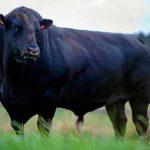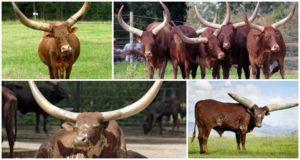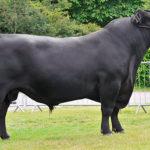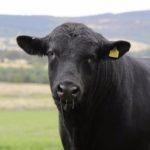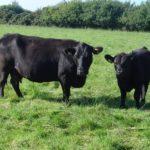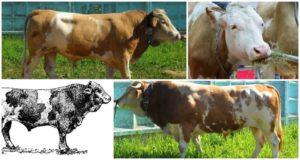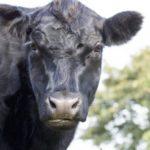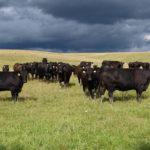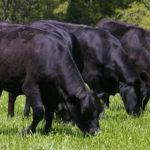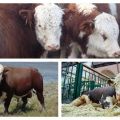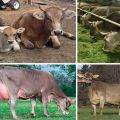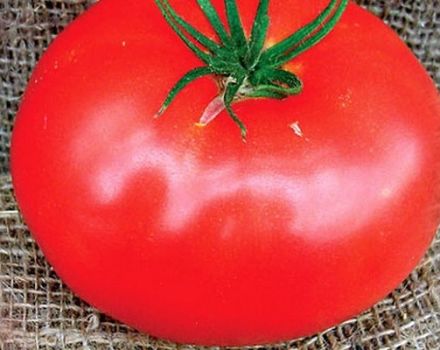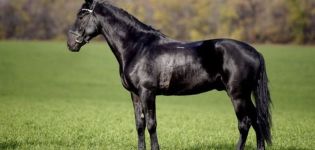Description and characteristics of Aberdeen Angus cattle, breeding and care
Among the beef cattle, representatives of the Aberdeen-Angus breed stand out. Their main feature is meat with thin fat layers, called marbled meat. It is appreciated all over the world by those who love exquisite meat delicacies. Consider the description and productive characteristics of the breed, the conditions of keeping and the rules of feeding, and the peculiarities of breeding.
Origin and distribution
Aberdeen Angus cattle was obtained in the highlands of Scotland. The ancestors of the representatives of the breed were the local hornless cattle of black color. The beginning of work with the breed falls on the second half of the 18th century, registration took place a little later - in 1873.
During this time, it was possible to improve the exterior of bulls and cows, the yield of meat and its quality, the animals became early maturing. Early maturity and excellent quality meat are the main qualities of the breed, for the sake of which it is kept in breeding farms.
In which countries is Aberdeen Angus grown
After the successful breeding of the Aberdeen breed in their homeland, they began to export it to Europe and North America. Today, Aberdeen Angus bulls and cows are raised in breeding farms in the USA and Canada, Russia (Kaluga and Voronezh regions) and the CIS, Australia and New Zealand, Argentina. They are bred to produce a distinctive tasting marbled beef, 80% of which is sourced from Black Angus.
Description and characteristics of the Aberdeen Angus breed
Cows of the Aberdeen breed are built according to the meat type. The animals are compact, short, 116-118 cm at the withers. They have a small head, short muzzle, short but large neck. The body is rectangular, muscular, even withers, back, voluminous chest. The legs are short and strong. The skin is thin, loose, with pronounced subcutaneous tissue. The color of the coat is pure black, when crossing the Aberdeen-Angus with other breeds, the calves inherit the black color and hornlessness.
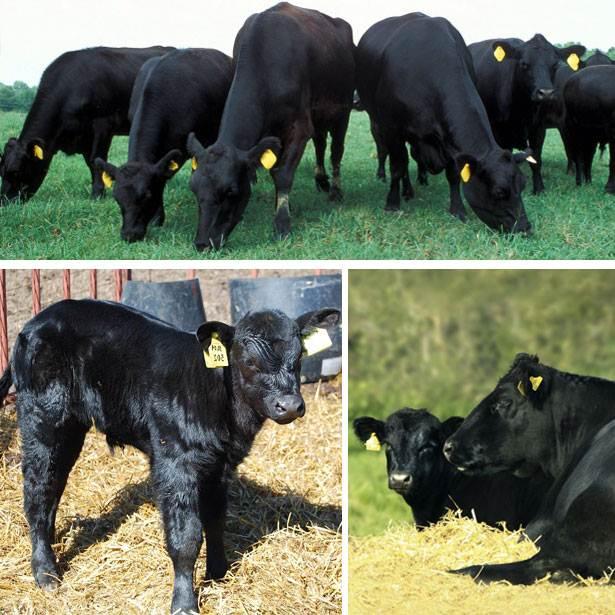
Calves are born with a weight of 22-28 kg, but they grow quickly, by six months, bulls can have a weight of 150-180 kg. The daily gain of cows is 1 kg. In adulthood, cows weigh 500-550 kg, bulls - 750-950 kg, for fattening males fatten up to 1 ton of weight. Slaughter meat yield is 60-70%, such a high rate is explained by the fact that cows have thin bones. The meat of Aberdeen Angus cows is tender, with fine fibers and layers of fat. The milk productivity of cows is low - up to 1.7 thousand liters, a lot of milk is used to feed the calves.
Disadvantages and advantages over other breeds
The disadvantages of the breed are not significant, so the Aberdeen Angus cattle is recognized as one of the best types of livestock for industrial breeding.
Subtleties of maintenance and care
Aberdeen has good adaptability, so they can be grown without creating special conditions for them. Cows can live in temperate, cold and hot climates. Only humidity has a negative effect on animals. With a successful organization, they can get by with open maintenance in the pasture, without reducing productivity.
In winter, especially in cold regions, they need to be kept in a warm barn, they just cannot be kept outside.
It is recommended to keep gobies loosely so that they can freely approach feed and drinkers. Animals should go for a walk every day and spend time on the walking area. A proper diet and moderate physical activity allow animals to remain healthy and fatten quickly.

The character traits of Aberdeen Angus cows dictate the rules for handling them. Animals love to communicate, they need to be taught to contact with people, lack of training leads to the fact that animals become wayward and aggressive.
Drawing up a diet
Calves are kept with their mothers, because of their natural diet, they grow quickly and rarely get sick, acquire natural immunity with milk. Gradually they are transferred to adult feed, feeding them with grain cuttings, mixed feed, fresh grass, and premixes are added to the food. Fresh clean water is given to the animals.
But there is a special scheme for feeding on wet corn, which makes it possible to obtain premium quality marbled meat. Aberdeen Angus cows are fattened according to an intensive scheme, which gives an average daily gain of 1-2 kg. Feeding takes 6 months. It is important that animals do not overeat, they become fat when overfeeding. If this happens, you need to immediately review the diet, as the quality of the future beef will suffer.
Individuals are selected for fattening that will not replace animals in the breeding herd. At 8 months old, at weaning age, they can weigh 200-230 kg. The best quality meat can be obtained from castrated bulls. Castration is performed at an early age. As a result of the operation, the structure of muscle fibers changes, they become thinner. But the advantages of castration are not only in this, gobies can be grazed next to the cows, there is no need to allocate pasture for them.
An Aberdeen Angus cow needs 6.5 feed to gain 1 kg of weight. units, that is, 6.5 kg of oats or 32 kg of fresh grass from meadows or 13 kg of medium-nutritive hay. The slaughter is carried out at the age of 18 months. In practice, it has been proven that in animals older than this age, weight gain does not increase, but stabilizes. In older cows, the quality of meat deteriorates, it becomes coarser.
Fattening on corn allows you to get perfect quality meat.Beef is used to cook steaks, cutlets, barbecue and other meat products. Aberdeen meat is soft, juicy, perfect structure.
Breeding
Although the breed is known for the fact that cows can adapt to different climates, you should try to buy calves that have grown as close as possible to where they will live. Then they will endure transportation and changing conditions with almost no stress.

Heifers of the Aberdeen Angus breed are ready for reproduction at 15 months, but you should not rush to happen them at this age, their body has not yet fully formed. Pregnancy will stop the development of the cow itself, the offspring will be small, weak and painful. Thanks to small newborns, calving is easy, without complications, the cow does not need help, she copes with everything herself. The representatives of the breed give birth to 1, less often 2 calves.
Like other calves, they need colostrum and maternal care immediately after birth. Babies can be left with the cow, the breed does not belong to dairy, almost all milk is drunk by the calf.
Pure-bred individuals have the most pronounced characteristics inherent in the breed, therefore, to obtain the famous marbled beef, it is recommended to keep thoroughbred individuals. If this is not possible, crossbreeds with other cattle breeds are bred. They receive valuable qualities from their Aberdeen Angus parent and acquire new ones, are distinguished by good health, vitality and live longer if used in breeding. This property of the breed is used to breed new promising breeds of cows.
Diseases
The Aberdeen Angus breed is characterized by genetic diseases, especially often they appear in purebred individuals, since they are carriers of recessive genes. Crossbreeds with other breeds do not get sick. Carriers of defective genes can be identified using a DNA test.
Diseases of Black Angus:
- Multiple arthrogryposis. It manifests itself in serious congenital defects and joint deformities, lesions of tendons, muscles and ligaments in calves. The disease is detected in meat and dairy cattle breeds and causes significant damage to livestock. Calves have reduced joint mobility, and leg muscles are weakened or atrophied.
- Neuropathic hydrocephalus. Anguses are born with a large, deformed head.
- Contracted arachnodactyly. In newborn calves, the mobility of the hip joints is reduced.
- Dwarfism.
Gobies and heifers with genetic diseases are always culled and not allowed for breeding, so that defective genes are not inherited. Aberdeen Angus cows can get sick with infectious and other cattle diseases, but when the standards of rearing are met and, being in good conditions, they rarely get sick. Therefore, you need to monitor the cleanliness of the premises where the animals are kept, the cleanliness of pastures and walking areas, feeders, vaccinations and routine veterinary examinations.
Aberdeen Angus cattle can be bred on farms and private households to obtain a special structure and excellent quality beef. The animals are quickly fed on a special diet, the slaughter yield of meat is at a high level.
